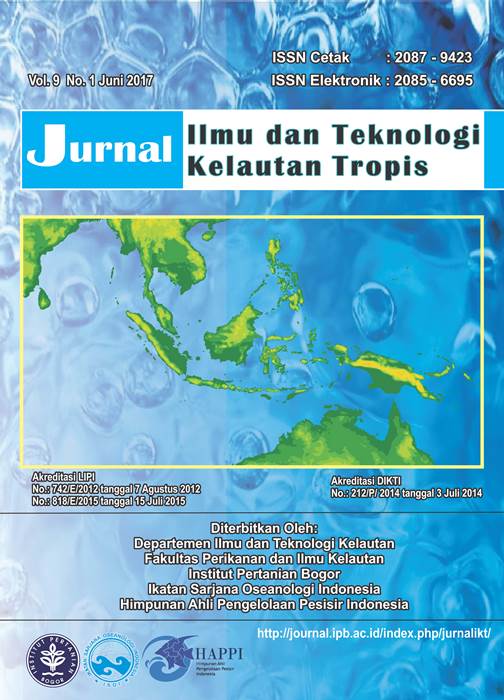EVALUATION OF THE USE OF FAAS FOR SR/CA CONCENTRATION ANALYSIS OF PORITES FROM AMBON BAY AND JUKUNG ISLAND CORAL
Abstract
The ratio of Sr/Ca concentration in coral is usually used as paleothermometer. Inductively Coupled Plasma (ICP) is an instrument, which is often used to analyze Sr/Ca concentration in Porites sp. The method is very sensitive and requires small amount of sample. However, the availability of this instrument is very limited. To deal with it, Flame Atomic Adsorption Spectrophotometer (FAAS) is an alternative in order to analyze the concentration of various elements include Sr and Ca. The aim of this study was to evaluate the result of the analysis methods of strontium and calcium concentration in coral using FAAS and compared to ICP results. Sample of Porites coral was taken from Ambon Bay and Jukung Island. The strontium and calcium concentration were analyzed using Flame Atomic Adsorption Spectrophotometer (FAAS). The results showed that the average of ratio Sr/Ca in coral from Ambon Bay and Jukung Island were 8.71 and 7.708 mmol/mol. The monthly variation of ratio Sr/Ca in coral from Ambon Bay were 6.28 - 10.24 mmol/mol, while in coral from Jukung Island were 1.005 - 10.914 mmol/mol. Result of FAAS analysis was too broad in range compared to ICP, ie 8.462 - 8.807 dan 8.45 – 8.7 mmol/mol. The range was estimated due to the occurrence of strontium and calcium ionization reaction in flame of FAAS.
Keywords: FAAS, coral, ratio Sr/Ca
Downloads
The author submitting the manuscript must understand and agree that the copyright of the article manuscript must be submitted/transferred to the Jurnal Ilmu dan Teknologi Kelautan Tropis. This work is licensed under the Creative Commons Attribution-ShareAlike 4.0 (CC BY-SA) International License in which the Author and Reader can copy and redistribute the material in any media or format, and remix, modify and build material for any purpose, but they must provide appropriate credit (citing articles or content), provide a link to the license, and indicate whether there is a change. If you mix, change, or create material, you must distribute your contribution under the same license as the original.



.png)














